In this post you’ll learn how to remove the background from images in PowerPoint (as pictured below) using two different tools. Knowing how to use these tools is important because they give you more ways to use pictures in your presentations.

Tool #1: The Set Transparent Color tool
This technique works best for pictures with 100% solid backgrounds (like the white backgrounds you find in stock photos). If your background is not 100% solid, you’ll have to use the Remove Background Tool instead.
Tool #2: The Remove Background tool
This tool works best for removing complicated backgrounds from photos and images. Also, this technique gives you the most flexibility when deciding what parts of the background to remove.
After removing your image background, you can then compress your images in PowerPoint to reduce your file size.
NOTE: If you are using a picture or image you found online, make sure you properly cite the creator or website you downloaded it from. To learn how to properly cite pictures and websites in your presentations, read our guide here.
Table of Contents
[Watch] Removing an image background in PowerPoint
You are currently viewing a placeholder content from Youtube. To access the actual content, click the button below. Please note that doing so will share data with third-party providers.
More InformationNOTE: These background removal techniques DO NOT work with vector graphic files such as SVGs, WMs and DRWs. If you have one of these files, you’ll first need to convert it to the JPEG or PNG file format to follow along.
You can alternatively make your image background transparent (instead of removing it) using the Set Transparent Color tool. See below for more details.
Take your PPT skills to the next level
Removing a white background from an image
The fastest way to remove an image background is to use the Set Transparent Color tool. The only catch is that it only works for removing solid colors, like white backgrounds.
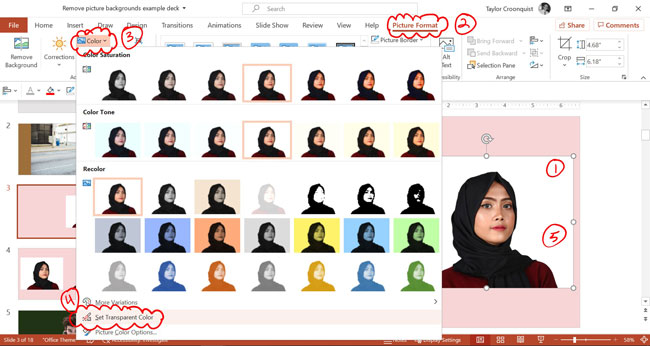
To remove a white background from an image in PowerPoint, simply:
- Insert and select a picture on your slide
- Navigate to the Picture Tools Format Tab
- Open the Color dropdown menu
- Select the Set Transparent Color tool (your cursor becomes a little pen with an arrow)
- Click on the color you want to remove from your background
PowerPoint turns that solid color transparent throughout your entire picture. In this case, the white background is removed.

This technique works best when you have a fairly simple background as pictured above. If your background is more complicated, you’ll need to use the Remove Background Tool instead. We cover this option further down in this article.
When Set Transparent Color doesn’t work
The Set Transparent Color tool works very well if you have photos with solid backgrounds. You will find these types of backgrounds on a lot of the stock photos you find online, such as on Pexels.
Just keep in mind that the Set Transparent Color tool does have limitations.
Example #1: This technique does not work well if the content of the image and its background are too similar in color. Because the entire image below is white, the woman’s face is removed with the background.

Example #2: This technique does not well with backgrounds that have shadows or gradients. Because the Set Transparent Color tool only removes a single color, gradients and shadows will be left in.

Example #3: This technique does not work well because of the detailing (like strands of hair, clothing, and skin).

For any of these types of scenarios, you’ll want to use the Remove Background tool instead.
Removing a complicated image background
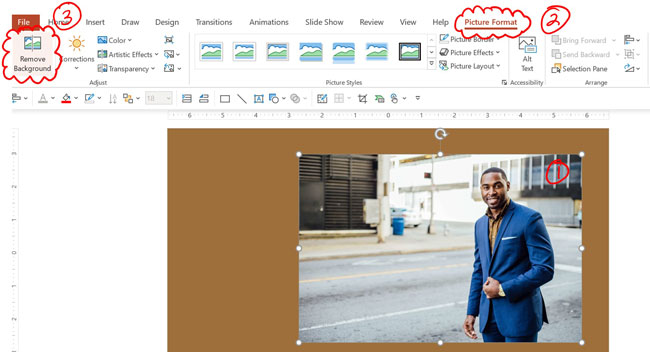
To remove a background from an image, simply:
- Select the image on your slide
- Navigate to the Picture Format tab
- Select the Remove Background command
- Adjust your removal settings (described below)
- Select Keep Changes
The magenta background portion of your image is then removed from your photo, as pictured below.

NOTE: Instead of removing the background from an image, you can instead add transparency to your picture. See how to do this, read our guide here.
Adjusting shat gets removed from your image
When you first select the Remove Background command, PowerPoint takes a guess at what you want to remove. In the picture below, that is shown in a pinkish (magenta) color.

While PowerPoint normally does a fairly decent job at guessing, it doesn’t always get it right.
Notice in the picture above that the woman’s arms are magenta, as is the bottom part of the man’s body. PowerPoint is guessing that those should be removed.
To fix it, all you need to do is specify what you want to keep and remove in your picture using the designated tools.
1. Mark areas to keep in your image
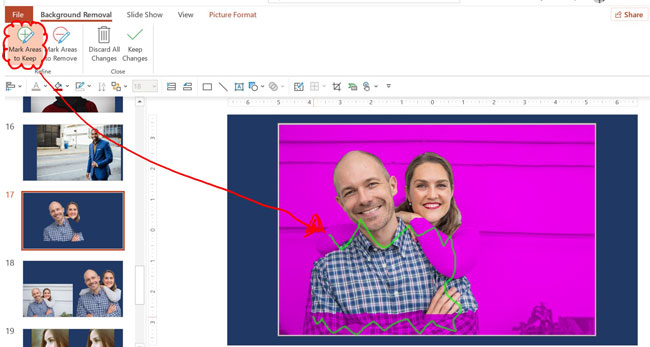
If PowerPoint doesn’t guess correctly and removes too many parts of your image, you can simply mark the areas you want to keep. To do that, simply:
- Select Mark Areas to Keep
- Click and draw over the parts of your photo you want to keep (creates green marks)
- Select Keep Changes
PowerPoint readjusts the parts of your image background that are removed. You might need to repeat this a few times to get it right.
2. Mark areas to remove in your image
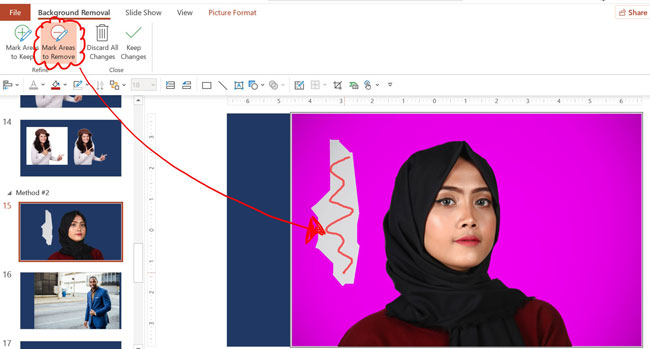
If PowerPoint guesses incorrectly and leaves too much background, you can mark areas to remove. To do that, simply:
- Select Mark Areas to Remove
- Click and draw over the parts of your photo you want to keep in Red
- Select Keep Changes
PowerPoint readjusts what parts of your background are removed. Keep in mind that depending on the complexity of your image, you might need to do this a few times to get it right.
3. When remove background doesn’t work
While the Remove Background tool will work for most backgrounds you want to remove, there are some limitations.
Limitation #1: If your picture is too homogenous, even the marking areas to keep and remove may not work. Sharp crisp photos work best.
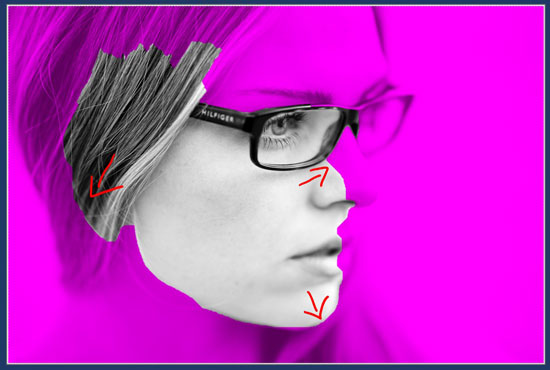
Limitation #2: It can be hard to remove the background around small details (like the background around strands of hair, binder rings, etc.).

Limitation #3: If the background is a gradient, is too complex or has shadowing, removing the background can also be very challenging.

Undoing your background removal
By default, when PowerPoint removes the background from your image, it merely hides it from you.
That means that at anytime you can revert back to your original image or change your mind about what parts you want to remove.
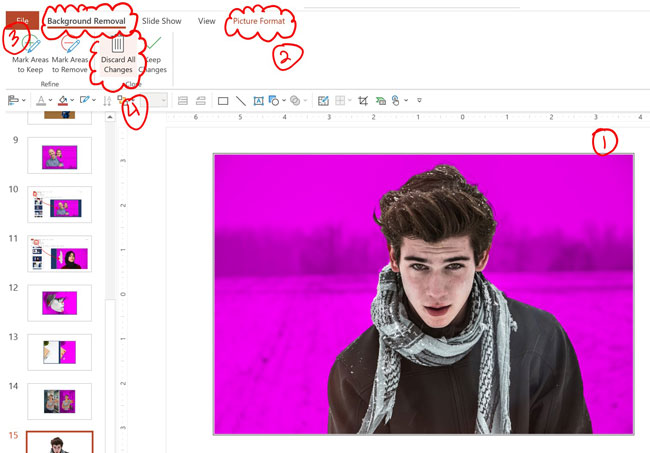
To undo your background removal (or start over) simply:
- Select your photo with the removed background
- Navigate to the Picture Format tab
- Click Remove Background
Your image background reappears and you can make more edits (or select Discard All Changes to revert back fully).
The only time that you are not be able to revert to your original image is if you compress it. To learn more about your image compression options to save on file size, read our guide here.
Conclusion
In summary, while the Set Transparent Color tool is the fastest way to remove your image background, it only works some of the time.
That’s why I recommend that you familiarize yourself with the Remove Background tool. If you work with lots of images, this will become your go-to tool for removing backgrounds in PowerPoint.
If either of these methods doesn’t work, you can move over to Photoshop for more precision.
While PowerPoint’s picture editing features are GREAT… it’s hard to beat a dedicated picture editing program like Photoshop.
To learn more about our PowerPoint training courses and other presentation resources, visit us here.
🔒 Unlock the PowerPoint Shortcuts Trusted by Industry Leaders KKR, American Express, HSBC, and More!
Join over 114,880 professionals from diverse fields including consulting, investment banking, advertising, marketing, sales, and business development who have supercharged their PowerPoint game with our proven methods.
✅ Customize compelling presentations effortlessly.
✅ Master time-saving techniques for faster deck creation.
✅ Boost your career prospects with top-notch PowerPoint skills.
Get FREE access to the Critical PowerPoint Shortcuts module of our premium training course by entering your name and email below.
DISCLAIMER: PC Users Only!
We respect your privacy and will keep your info safe and confidential.
